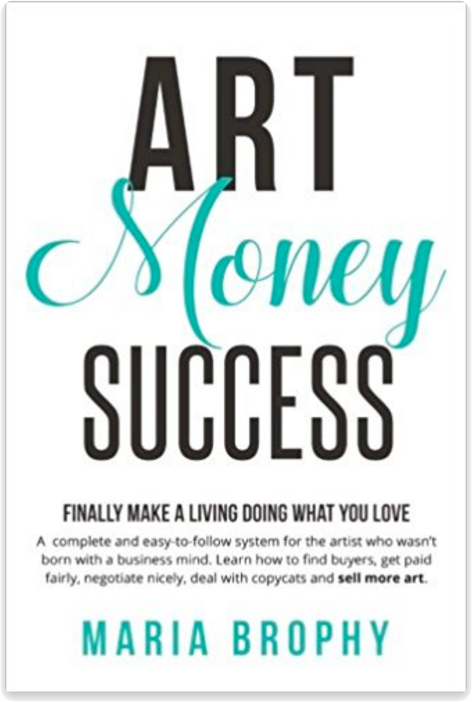
Most of my illustration clients are wonderful to work with. I’m blessed in that way.
However, every now and again I run into a business deal that just isn’t a virtuous match.
A recent scuffle with a not-so-ethical client has inspired me to write this article to help you avoid being stiffed on payment.
I have written about getting “ripped off” many times because it happens so often to artists.
Usually it’s their own fault for not getting a deposit up front and for not writing up a proposal or agreement.
But, let’s give the artist (and me) a break for a moment. We are all human – we get caught up in the excitement of a new idea so much that we sometimes throw our business sense out the window.
But no more! In this article, I’m going to empower you with two very effective tools:
1 – PREVENTION: A method that will ensure that you are paid for your work every time.
2 – RESOLUTION: A sure-fire method to resolve a situation when the client won’t pay.
But first, can you relate to this common scenario:
A client calls on you with an exciting idea for a new project. They need your creative genius to transform it into a beautiful visual. (You are flattered – and this is where the trap first opens.)
You are swept away in their enthusiasm. You fervently begin the work without a deposit or a well-written agreement.
The project starts off great; you’re having fun bringing this client’s vision to life.
Then, they start giving you a lot more to do than what was originally planned. They keep asking for more work and the project drags out. You’re losing money by turning down other work because this has become the never-ending project.
You realize you’ve grossly undercharged for what you’ve been roped into.
To add to your stress, they have excuses for not making payment. They string you out like a dead-beat dad.
Now, you feel taken advantage of and you lose all enthusiasm. It’s become a project of dread. When the client calls, your stomach hurts.
Where did things go wrong?
I promise you, this scenario can be easily avoided. I know because this recently happened to us, and it’s because I let my guard down and didn’t follow my own policy of “Final payment is due before final art is delivered.” It’s also the first time we’ve been stiffed in eons. (And wouldn’t you know, it was a friend – they can be the worst offenders. Needless to say, the friendship has been compromised. Read “Doing Business with Friends” for tips on this topic)
HOW TO PREVENT BEING STIFFED
Your mother was right; prevention is the cure to everything. Have a payment policy in place. Here’s the policy I use (and will never again make an exception to):
PUT EVERYTHING IN WRITING: Your price quote and your parameters should be provided to your client in writing BEFORE you start sketching or doing any work on the project.
SPELL-OUT PARAMETERS/LIMITS TO AVOID PROBLEMS: Here’s a sample of parameters we use, which we have learned the hard way:
SKETCH LIMIT: Price includes up to three sketches. Any additional sketch changes will incur a fee of $100 each (this ensures that the client is very clear on what they want in the first place. If not, then they pay extra for the extra work.)
ADVANCE PAYMENT: We require 50% up front. This is a non-refundable advance (deposit), so if the client changes their mind after we put 40 hours into it, they don’t get granted rights to use the art nor do they get their money back. This protects you from working for free.
BALANCE DUE AT COMPLETION: Specify that the full balance is due at completion. And it doesn’t matter if they come to get the art or not, the balance is due on that date.
DO NOT give the client finished art files until the balance is paid in full. Send low res images so they can see that it’s complete. But don’t send the hi-res images until it’s done. Your contract should spell this out so there are no surprises.
GRANT OF RIGHTS HAPPENS ONLY IF PAID ON TIME: THIS IS YOUR STRONGEST PREVENTION LANGUAGE! Make sure your proposal or agreement states something like:
“Rights to use the art are granted upon receipt of payment in full, provided that payment in full is made within thirty days of completion date. If payment is made after thirty days of completion, this proposal (or contract) is null and void and rights will not be granted without re-evaluation by the Artist and determined in writing. All payments made to Artist are non-refundable.”
Without a written grant of rights, they can’t legally use the art. Never grant rights in writing until after they have paid in full, and on time. If you don’t specify a date that payment must be made, then they can try to pay you ten years later and assume rights then. (They can try; it most likely won’t fly in court. Even if you win, it will be a waste of your time and money.)
In my bi-monthly newsletter I share PDF’s with sample Agreement language that spells all these details out, and you can use the same for yourself. To sign up for my newsletters, click here.
WHAT HAPPENS WHEN THINGS GO WRONG?
So your client (or friend, in my case) had you do all the work, they sucked your soul dry, and they still won’t pay you the rest of what they owe you. Now what?
This is where you have to make a choice: Be the victim or be hardnosed.
I don’t know about you, but I’d rather take things into my own hands than roll up in a ball on the floor and cry.
THE FOLLOWING IS THE BEST ADVICE YOU’LL EVER GET, IF YOU TAKE IT:
My best friend Bridget, the beautiful, genius Realtor in Encinitas, taught me this principle:
Give people deadlines and consequences.
And then, just as you would with a child, follow through.
DEADLINES AND CONSEQUENCES: This works for anything, but in business it has been a lifesaver for me. No more worrying and waiting to see if someone is going to do the right thing. I, MYSELF, take control of the situation.
If your client hasn’t paid in full, and the work has been completed, send them a nice letter that contains DEADLINES & CONSEQUENCES, such as this one:
Dear Perry Pickle,
This is a friendly reminder that payment was due on April 5, 2012, as all work was completed on that date. Please send full payment in the amount of $1,250 no later than April 15th so that we won’t have to incur late fees. (NOTE to reader: Specifics are key – you give them the due date, the reason it was due, the amount due, and a date they must get final payment to you.)
Also, be aware that grant of art usage rights will occur when payment has been made in full, as long as payment is made no later than May 5, 2012, as specified in the contract.
If payment is not received by April 15th, please add 3% interest to your payment. (NOTE to reader: This is one consequence to not paying – an interest charge.)
Once payment has been made in full, you will have rights to use the artwork as specified in the contract.
If payment is not made by May 5th, rights will not be granted and you will not have legal rights to use the art. (NOTE to reader: this is the 2nd consequence, and the most important.)
Please let me know if you have any questions. Thank you, Joe Artist
DEADLINES AND CONSEQUENCES Put you in the driver seat, which is right where you want to be at all times when it comes to your art business.
If the client does not pay by the due date, send them an updated invoice with interest charges applied.
If they don’t pay by your final date (in this example by May 5th), send a final letter notifying them that they have not been granted rights to use the artwork and that any use will be considered infringement.
Let them know that the art will now be available for you to license or sell to other clients. As the copyright owner, you have the right to do this, as rights have not been granted.
Send the letter by Certified Mail and make sure you get a return receipt for your records.
After sending that final letter, file it away and forget about it. Be proud of yourself that you are a good businessperson. Pat yourself on the back!
ALSO: Make sure you always copyright your artwork, in the event the client attempts to use the art somehow without the grant or final payment made. This way, if you end up in court, your filed copyrights will entitle you to attorney’s fees and other awards.
Please, take your business into your own hands. Don’t let anyone, not even a friend, jack you around!
Maria xxoo
.














